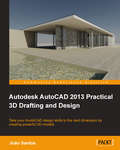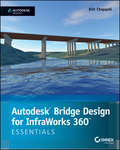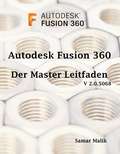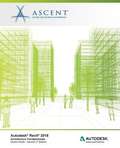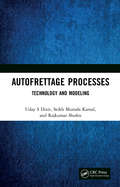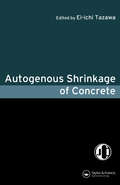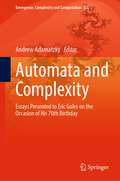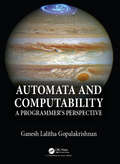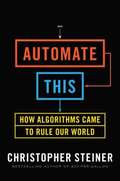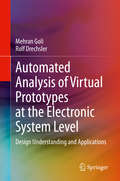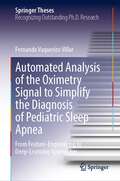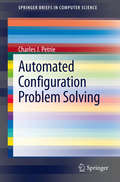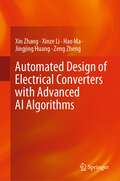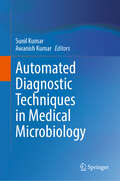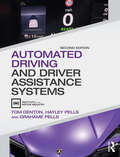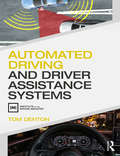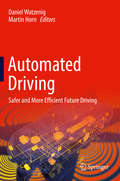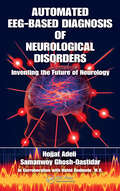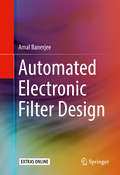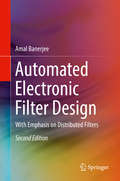- Table View
- List View
Autodesk AutoCAD 2013 Practical 3D Drafting and Design
by Joao SantosThis book is written in a practical and friendly style with practical tutorials, exercises, and detailed images which will help you master the third dimension. This book is intended for everyone who wants to create accurate 3D models in AutoCAD, like architecture, engineering, or design professionals, and students. Only basic understanding of 2D AutoCAD is needed.
Autodesk Bridge Design for InfraWorks 360 Essentials
by Eric ChappellLearn the fundamentals of the Bridge Design module for AutodeskInfraWorks 360 Autodesk Bridge Design for InfraWorks 360 Essentials isan accessible, unique learning resource that offers engineers anddesigners succinct explanations and hands-on exercises that providethe keys to the software's many features and functions. Get up tospeed on bridge design with this Autodesk Official Press book,which is filled with illustrative screenshots and step-by-stepinstruction for effective bridge design. Once you learn how tonavigate this powerful software, you can access the cross-platformmodel sharing and collaboration via the software's cloudcapabilities, and you'll see how the model can be exported intoCivil 3D for final design work and documentation.This essential resource shows how to access the tools that drivestakeholder involvement with design-feed social collaboration, andoffers information on how to connect your designs to real-worldenvironments with live maps and geo-location tools.Unlock the power of InfraWorks' software for designing andcollaboration during the bridge design processLearn to use the powerful module-specific tools and functionsof the software, such as analyzing profiles and setting upscenarios for various materialsAccess the illustrative tutorial steps that put you on the fasttrack for implementing the softwareDiscover how you can improve data consistency and evaluate moredesign options in less timeWith Autodesk Bridge Design for InfraWorks 360 Essentialsyou'll learn how to access the power of the bridge design softwarethat puts you ahead of the competition.
Autodesk Drainage Design for InfraWorks 360 Essentials
by Eric ChappellGet up to speed on drainage design with Autodesk InfraWorks360 Autodesk Drainage Design for InfraWorks 360 Essentialsoffers an indispensible resource to InfraWorks' Drainage Designmodule. The module's interface includes tools that enable engineersto import and combine other data that goes beyond the baseInfraWorks software. This book provides step-by-step instructionfor creating new drainage designs, or adding detail to existingdesigns using InfraWorks 360. Filled with illustrative examples androbust design instructions, this book reveals how to best use thepowerful tools and functions of the Drainage Design module, andincludes information on analyzing profiles and setting up scenariosfor various materials.This Autodesk Official Press book covers the basics for creatingproposals and design intent within the context of real siteconditions, and shows how the software's cloud-based capabilitiesenable teams from around the globe to store, manage, and accessmodels from desktop or mobile devices.Includes an approachable introduction to InfraWorks forDrainage Design moduleFilled with practical, real-world exercises and additionaltask-based tutorials that show how to become quickly productivewith the softwareShows how to access the cloud-based 3D visualizations thatallow designers and engineers to communicate and get betterinformed inputOffers a key resource to the technology that providesgovernment and civil engineers the ability to fast-trackinfrastructure projectsAutodesk Drainage Design for InfraWorks 360 Essentials isthe introduction needed for accessing the specialized tools foranalysis, design, and documentation of drainage design and stormwater projects.
Autodesk Fusion 360- Der Master-Leitfaden
by Samar MalikAutodesk Fusion 360- Der Master-Leitfaden ist das ultimative Buch, um tiefgreifende Kenntnisse der Fusion 360-Software zu erlangen. Das Buch wurde gemäß den Updates vom Oktober 2019 veröffentlicht, wo die Benutzeroberfläche grundlegend geändert und viele weitere Funktionen hinzugefügt wurden. Die im gesamten Buch verwendete Sprache ist einfach, egal ob Sie ein Kapitel lesen, um Konzepte zu klären, oder Tutorials folgen, um reale Projekte zu erstellen. Sie werden das Konzept und die Funktionsweise der Tools mühelos verstehen. Warum dieser Leitfaden? Sie könnte denken das diese Frage offensichtlich ist. Lassen Sie mich Ihnen die Gründe nennen, warum es der ultimative Leitfaden zum Erlernen von Fusion 360 ist. • Unter jedem Werkzeug wird das Konzept erklärt, die zu verwendende Vorgehensweise und der Zweck des Werkzeugs. Diese Methode wird im gesamten Buch angewendet. • Kompakt in Größe und in leicht verständlicher Sprache geschrieben, die Befehle sind Sowohl in Deutsch als auch in Englisch •3 der 11 Kapiteln sind speziell für branchenbezogene Übungen konzipiert, mit denen das Lernen geübt und analysiert werden kann. Auch komplexe Übungen werden mit dem einfachsten möglichen Verfahren angegeben. • Es wird eine schrittweise Anleitung bereitgestellt, um die Arbeitsweise der Werkzeuge zu verstehen und ein Modell erstellen zu können. • Jedes Werkzeug wird mit einer Illustration versehen, damit der Benutzer es praktisch nachvollziehen kann. Wen spricht das Buch an? Wenn Sie jemals ein Medium benötigt haben, um Ihre Ideen in ein 3D-Modell zu integrieren, sei es ein Schulprojekt oder ein Motorrad, dann ist Autodesk Fusion 360 für Sie gemacht und der Leitfaden für Sie geschrieben. Wenn Sie • Ein Student, der seine Gedanken in ein 3D-Modell umsetzen möchte • Ein Arbeitssuchender im Bereich Forschung und Entwicklung • Ein Konstrukteur oder Ingenieur • Eine Person, die am 3D-Druck arbeitet • Ein Hochschu
Autodesk Inventor Exercises: for Autodesk® Inventor® and Other Feature-Based Modelling Software
by Bob McFarlaneThis practical resource provides a series of Inventor® exercises covering several topics, including: sketches part models assemblies drawing layouts presentations sheet metal design welding for users with some familiarity with Autodesk® Inventor, or other similar feature-based modelling software such as Solid Works ®, CATIA ®, Pro/ENGINEER and Creo Parametric, and who want to become proficient. Exercises are set out in a structured way and are suitable for releases of Inventor from versions 7 to 13.
Autodesk Inventor Professional 2018 for Designers
by Sham TickooAutodesk Inventor Professional 2018 for Designers is a comprehensive textbook that introduces the users to Autodesk Inventor 2018, a feature-based 3D parametric solid modeling software. All environments of this solid modeling software are covered in this textbook with thorough explanation of commands, options, and their applications to create real-world products. <p><p>The mechanical engineering industry examples that are used as tutorials and the related additional exercises at the end of each chapter help the users to understand the design techniques used in the industry to design a product. Additionally, the author emphasizes on the solid modeling techniques that will improve the productivity and efficiency of the users. <p><p>After reading this textbook, the users will be able to create solid parts, sheet metal parts, assemblies, weldments, drawing views with bill of materials, presentation views to animate the assemblies, and apply direct modeling techniques to facilitate rapid design prototyping. Also, the users will learn the editing techniques that are essential for making a successful design.
Autodesk Revit 2018: Architecture Fundamentals
by ASCENT - Center for Technical Knowledge<p>The Autodesk Revit software is a powerful Building Information Modeling (BIM) program that works the way architects think. The program streamlines the design process through the use of a central 3D model, where changes made in one view update across all views and on the printable sheets. <p>This student guide is designed to teach you the Autodesk Revit functionality as you would work with it throughout the design process. You begin by learning about the user interface and basic drawing, editing, and viewing tools. Then you learn design development tools including how to model walls, doors, windows, floors, ceilings, stairs and more. Finally, you learn the processes that take the model to the construction documentation phase. <p>Since building projects are extremely complex, the Autodesk Revit software is also complex. The objective of the Autodesk(R) Revit(R) 2018 Architecture: Fundamentals student guide is to enable students to create full 3D architectural project models and set them up in working drawings. This student guide focuses on basic tools that the majority of users need. <p>Topics Covered: <p> <li>Understanding the purpose of Building Information Management (BIM) and how it is applied in the Autodesk Revit software. <li>Navigating the Autodesk Revit workspace and interface. <li>Working with the basic drawing and editing tools. <li>Creating Levels and Grids as datum elements for the model. <li>Creating a 3D building model with walls, curtain walls, windows, and doors. <li>Adding floors, ceilings, and roofs to the building model. <li>Creating component-based and custom stairs. <li>Adding component features, such as furniture and equipment. <li>Setting up sheets for plotting with text, dimensions, details, tags, and schedules. <li>Creating details.</li> <p> <p>Prerequisites: <p> <li>An understanding of architectural terminology is an asset.</li>
Autodesk Roadway Design for InfraWorks 360 Essentials
by Eric ChappellLearn the fundamentals of Roadway Design for InfraWorks and InfraWorks 360Autodesk Roadway Design for InfraWorks 360 Essentials offers engineers a hands-on guide that includes straightforward explanations and real-world exercises to demonstrate the software's features and functions. This indispensible book is filled with compelling screenshots that illustrate the steps needed to get up to speed with InfraWorks and InfraWorks 360, both of which give users the power to accelerate the roadway design process and streamline decision making. The book offers specific guidance for creating new designs, and includes information on how to best use the powerful module-specific tools and functions, such as intersection optimization and sightline analysis for safety.Autodesk Roadway Design for InfraWorks 360 Essentials introduces users to the Roadway Design interface and shows how to combine 2D CAD, GIS, raster, and 3D models, including those created with Autodesk AutoCAD Civil 3D civil engineering software. The resource is designed so users can download starting and ending files for the exercises, making it easy to go anywhere in the book and compare results with the professionals.Offers a how-to guide for accessing the exercises and task-based tutorials that will allow users to quickly become productive with the InfraWorks' roadway software moduleReveals the basics for creating compelling simulations and visualizationsShows how to store, manage, and share roadway design modelsTeaches how to access the software's unique design toolsAutodesk Roadway Design for InfraWorks 360 Essentials is the one guide that offers the key to unlocking the potential of powerful design and collaboration software.
Autofrettage Processes: Technology and Modelling
by Rajkumar Shufen Uday Dixit Seikh KamalAutofrettage Processes: Technology and Modeling deals with the technology and modeling of autofrettage processes, explaining the subject in a lucid manner. It highlights how the theory of plasticity and finite element modeling are applied in the modeling of autofrettage processes. Aimed at senior students of mechanical, production, automobile, and chemical engineering, it has the potential to directly benefit practicing engineers and industrials, owing to the inclusion of topics like thermal autofrettage. Key Features: Provides a general introduction to autofrettage Covers the application of theory of plasticity and finite element modeling of autofrettage processes Offers exposure to newer autofrettage processes that to date have not been implemented in industries, along with useful practical data
Autogenous Shrinkage of Concrete: Proceedings Of The International Workshop Organized By Jci (japan Concrete Institute)
by Ei-Ichi TazawaThis book forms the proceedings of a workshop held in Hiroshima in June 1998 and derive from the work of a Technical Committee of the Japan Concrete Institute. Topics include test and prediction methods, the science of autogenous shrinkage, strain and stress, and consequent design concerns.
Automata and Complexity: Essays Presented to Eric Goles on the Occasion of His 70th Birthday (Emergence, Complexity and Computation #42)
by Andrew AdamatzkyThis book commemorates Eric Goles’s achievements in science and engineering. Eric Goles is one of the world leaders in the field of automata and complexity. His groundbreaking discoveries are in the theory and analysis of complex systems, particularly in the field of discrete systems dynamics such as neural networks, automata networks, majority networks, bootstrap percolation models, cellular automata, computational complexity theory, discrete mathematics, and theoretical computer science. Topics include cellular automata, complex networks, models of computation, expansive systems, sandpile automata, Penrose tilings, Boolean automata, models of infection, Fibonacci trees, dominos, reversible automata, and fungal automata. The chapters are authored by world leaders in computer science, physics, mathematics, and engineering. The book will be a pleasure to explore for readers from all walks of life, from undergraduate students to university professors, from mathematicians, computer scientists, and engineers to chemists and biologists.
Automata and Computability: A Programmer's Perspective
by Ganesh GopalakrishnanAutomata and Computability is a class-tested textbook which provides a comprehensive and accessible introduction to the theory of automata and computation. The author uses illustrations, engaging examples, and historical remarks to make the material interesting and relevant for students. It incorporates modern/handy ideas, such as derivative-based parsing and a Lambda reducer showing the universality of Lambda calculus. The book also shows how to sculpt automata by making the regular language conversion pipeline available through a simple command interface. A Jupyter notebook will accompany the book to feature code, YouTube videos, and other supplements to assist instructors and studentsFeatures Uses illustrations, engaging examples, and historical remarks to make the material accessible Incorporates modern/handy ideas, such as derivative-based parsing and a Lambda reducer showing the universality of Lambda calculus Shows how to "sculpt" automata by making the regular language conversion pipeline available through simple command interface Uses a mini functional programming (FP) notation consisting of lambdas, maps, filters, and set comprehension (supported in Python) to convey math through PL constructs that are succinct and resemble math Provides all concepts are encoded in a compact Functional Programming code that will tesselate with Latex markup and Jupyter widgets in a document that will accompany the books. Students can run code effortlessly href="https://github.com/ganeshutah/Jove.git/"here.
Automate This
by Christopher SteinerHow the rise of computerized decision-making affects every aspect of business and daily life The bot takeover began with high frequency trading on Wall Street, and from there it spread to all manners of high-level tasks--such as diagnosing illnesses or interpreting legal documents. There is no realm of human endeavor safe from algorithms that employ speed, precision and nuance. In this fascinating book, Steiner tells the story of how algorithms took over and shows why the "bot revolution" is about to spill into every aspect of our lives. We meet bots that are driving cars, penning haikus, and writing music mistaken for Bach's. They listen in on customer service calls and figure out what Iran would do in the event of a nuclear standoff. On Wall Street, pre-programmed algorithmic deals are executed by machines faster than any human could--leaving human investors at a severe disadvantage. But what will the world look like when algorithms control our hospitals, our roads, and our national security? Is a stock market controlled by high-speed trading bots worth investing in? And what role will be left for doctors, lawyers, writers, truck drivers, and many others?
Automate Your Home Using Go
by Mike Riley Ricardo GerardiTake control of your home and your data with the power of the Go programming language. Build extraordinary and robust home automation solutions that rival much more expensive, closed commercial alternatives, using the same tools found in high-end enterprise computing environments. Best-selling Pragmatic Bookshelf authors Ricardo Gerardi and Mike Riley show how you can use inexpensive Raspberry Pi hardware and excellent, open source Go-based software tools like Prometheus and Grafana to create your own personal data center. Using the step-by-step examples in the book, build useful home automation projects that you can use as a blueprint for your own custom projects. With just a Raspberry Pi and the Go programming language, build your own personal data center that coordinates and manages your home automation, leveraging the same high-powered software used by large enterprises. The projects in this book are easy to assemble, no soldering or electrical engineering expertise required. Build a temperature monitor that can send alerts any time defined thresholds are exceeded and report the temperature readings on a time-based series chart. Change the color of lights to visually indicate the current outdoor weather status. Create a networked motion detector that triggers an alert any time motion is detected, such as a door opening or closing, a pet wandering around, or deliveries or visitors arriving on your front porch. Even have these triggers initiate a more complex Go-based automation sequence. Integrate a small, high-resolution camera into a bird feeder that takes excellent, up-close photos whenever a bird perches at the feeder, and broadcasts them to your Discord server where your family and friends can see these wildlife captures in real time. Control your home with hardware you configure, and manage it with Go code that you create and modify any time you want to enhance your home automation capabilities. What You Need: Readers should be familiar with the Go programming language and have working knowledge of Linux. Free, open source Go-based libraries and utilities are available for download from the Internet. Readers will also need a working Raspberry Pi 3+ or higher, and a Pi Pico W microcontroller. Several other inexpensive electronic parts (touch sensors, motion detectors) are also needed for some of the projects. A Philips Hue base lighting system is also needed for the weather monitor project.
Automated Analysis of Virtual Prototypes at the Electronic System Level: Design Understanding and Applications
by Rolf Drechsler Mehran GoliThis book describes a set of SystemC‐based virtual prototype analysis methodologies, including design understanding, verification, security validation, and design space exploration. Readers will gain an overview of the latest research results in the field of Electronic Design Automation (EDA) at the Electronic System Level (ESL). The methodologies discussed enable readers to tackle easily key tasks and applications in the design process.
Automated Analysis of the Oximetry Signal to Simplify the Diagnosis of Pediatric Sleep Apnea: From Feature-Engineering to Deep-Learning Approaches (Springer Theses)
by Fernando Vaquerizo VillarThis book describes the application of novel signal processing algorithms to improve the diagnostic capability of the blood oxygen saturation signal (SpO2) from nocturnal oximetry in the simplification of pediatric obstructive sleep apnea (OSA) diagnosis. For this purpose, 3196 SpO2 recordings from three different databases were analyzed using feature-engineering and deep-learning methodologies. Particularly, three novel feature extraction algorithms (bispectrum, wavelet, and detrended fluctuation analysis), as well as a novel deep-learning architecture based on convolutional neural networks are proposed. The proposed feature-engineering and deep-learning models outperformed conventional features from the oximetry signal, as well as state-of-the-art approaches. On the one hand, this book shows that bispectrum, wavelet, and detrended fluctuation analysis can be used to characterize changes in the SpO2 signal caused by apneic events in pediatric subjects. On the other hand, it demonstrates that deep-learning algorithms can learn complex features from oximetry dynamics that allow to enhance the diagnostic capability of nocturnal oximetry in the context of childhood OSA. All in all, this book offers a comprehensive and timely guide to the use of signal processing and AI methods in the diagnosis of pediatric OSA, including novel methodological insights concerning the automated analysis of the oximetry signal. It also discusses some open questions for future research.
Automated Configuration Problem Solving (SpringerBriefs in Computer Science)
by Charles J. PetrieAutomated Configuration has long been the subject of intensive research, especially in Artificial Intelligence. It is a pervasive problem to be solved, and it is a good test of various knowledge representation and reasoning techniques. The problem shows up in applications such as various electrical circuit design, utility computing and even concurrent engineering. Automated Configuration Problem Solving defines the ubiquitous problem, illustrates the various solution techniques, and includes a survey using these techniques from the mid-70's until the mid-90's. During this time, various general approaches were developed, and then become more specialized. This book covers the development of the general problem solving techniques for automated configuration, which are based on both published academic work and patents.
Automated Design of Electrical Converters with Advanced AI Algorithms
by Xin Zhang Hao Ma Jingjing Huang Xinze Li Zeng ZhengA power converter is a device used in electrical engineering, power engineering, and the electric power sector to convert electric energy from one form to another, such as converting between AC and DC, changing voltage or frequency, or a combination of these. It is used in a variety of applications, such as industrial drives, power supply, energy generating equipment, consumer goods, electrical vehicles/aeroplanes/ships, smart grids and more.This book will open a door for engineers to design the power converters via the artificial intelligence (AI) method. It begins by reviewing current AI technology in power converters. The book then introduces customized AI algorithms for power converters that take into account the particular characteristics of power converters. The book then presents a set of AI-based design methodologies for power devices, including DC/DC converters, resonant DC/DC converters, bidirectional DC/DC converters, DC/AC inverters, and AC/DC rectifiers. This is the first book to cover all you need to know about using AI to create power converters, including a literature review, algorithm, and circuit design.
Automated Diagnostic Techniques in Medical Microbiology
by Sunil Kumar Awanish KumarThis book will explore the knowledge of current diagnostic automation techniques applied in the field of clinical microbiology, tropical diseases, POCT, etc. There is no such type of book related to this topic. This book will help clinicians, microbiologists, and researchers to make diagnostic algorithms for infectious diseases and help them in early diagnosis. Automation in clinical microbiology has revolutionized routine practice in diagnostic cum research in medical microbiology. This book covers the recent updates and advances in diagnostic microbiology and provides new techniques related to Genomic, Proteomic, and metabolomics in microbiology. This book will intensely discuss the new and innovative automation techniques available for diagnosis in the microbiology laboratory. This book is more focused on automation techniques, which are used in the early detection of infectious diseases even caused by rare microorganisms. Furthermore, this book has complied with the chapters that provide insights to readers with comprehensive and usable knowledge on automation techniques in diagnostic microbiology.
Automated Driving and Driver Assistance Systems
by Tom Denton Hayley Pells Grahame PellsAutomated vehicles are poised to revolutionise transportation, yet AdvancedDriver Assistance Systems (ADAS) represent the cutting-edge technologyof today. Written in accessible language, Automated Driving and DriverAssistance Systems breaks down complex concepts to highlight theintegration of existing systems in modern vehicles. Written in line with theUK’s Autonomous Vehicles Act (2024), this heavily revised new editionoffers practical insights and case studies for an international audience.This book is essential for automotive students at both further educationand undergraduate levels, as well as for practising technicians andprofessionals in the automotive industry.
Automated Driving and Driver Assistance Systems
by Tom DentonAutomated vehicles are set to transform the world. Automated driving vehicles are here already and undergoing serious testing in several countries around the world. This book explains the technologies in language that is easy to understand and accessible to all readers. It covers the subject from several angles but in particular shows the links to existing ADAS technologies already in use in all modern vehicles. There is a lot of hype in the media at the moment about autonomous or driverless cars, and while some manufacturers expect to have vehicles available from 2020, they will not soon take over and it will be some time before they are commonplace. However, it is very important to be ready for the huge change of direction that automated driving will take. This is the first book of its type available and complements Tom Denton's other books.
Automated Driving: Safer and More Efficient Future Driving
by Martin Horn Daniel WatzenigThe main topics of this book include advanced control, cognitive data processing, high performance computing, functional safety, and comprehensive validation. These topics are seen as technological bricks to drive forward automated driving.The current state of the art of automated vehicle research, development and innovation is given. The book also addresses industry-driven roadmaps for major new technology advances as well as collaborative European initiatives supporting the evolvement of automated driving. Various examples highlight the state of development of automated driving as well as the way forward.The book will be of interest to academics and researchers within engineering, graduate students, automotive engineers at OEMs and suppliers, ICT and software engineers, managers, and other decision-makers.
Automated EEG-Based Diagnosis of Neurological Disorders: Inventing the Future of Neurology
by Hojjat Adeli Samanwoy Ghosh-DastidarBased on the authors' groundbreaking research, Automated EEG-Based Diagnosis of Neurological Disorders: Inventing the Future of Neurology presents a research ideology, a novel multi-paradigm methodology, and advanced computational models for the automated EEG-based diagnosis of neurological disorders. It is based on the ingenious integration of thr
Automated Electronic Filter Design: With Emphasis On Distributed Filters
by Amal BanerjeeThis book describes a novel, efficient and powerful scheme for designing and evaluating the performance characteristics of any electronic filter designed with predefined specifications. The author explains techniques that enable readers to eliminate complicated manual, and thus error-prone and time-consuming, steps of traditional design techniques. The presentation includes demonstration of efficient automation, using an ANSI C language program, which accepts any filter design specification (e. g. Chebyschev low-pass filter, cut-off frequency, pass-band ripple etc. ) as input and generates as output a SPICE(Simulation Program with Integrated Circuit Emphasis) format netlist. Readers then can use this netlist to run simulations with any version of the popular SPICE simulator, increasing accuracy of the final results, without violating any of the key principles of the traditional design scheme.
Automated Electronic Filter Design: With Emphasis on Distributed Filters
by Amal BanerjeeThis book describes a novel, efficient and powerful scheme for designing and evaluating the performance characteristics of any electronic filter designed with predefined specifications. The author explains techniques that enable readers to eliminate complicated manual, and thus error-prone and time-consuming, steps of traditional design techniques. The presentation includes demonstration of efficient automation, using an ANSI C language program, which accepts any filter design specification (e. g. Chebyschev low-pass filter, cut-off frequency, pass-band ripple etc. ) as input and generates as output a SPICE(Simulation Program with Integrated Circuit Emphasis) format netlist. Readers then can use this netlist to run simulations with any version of the popular SPICE simulator, increasing accuracy of the final results, without violating any of the key principles of the traditional design scheme.
